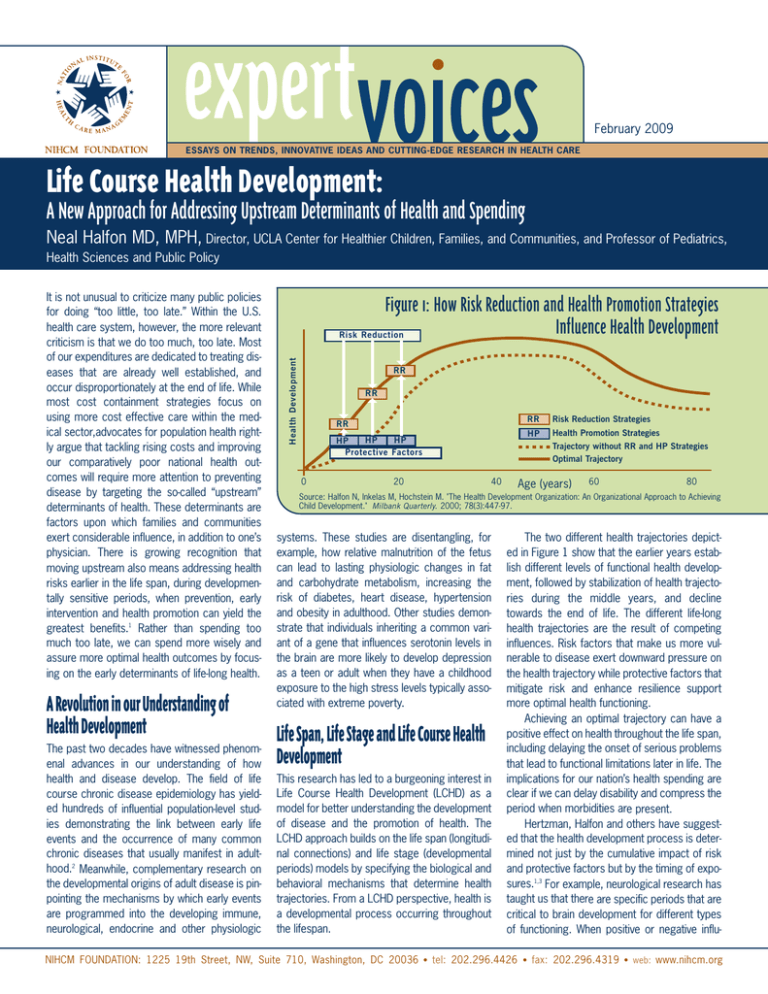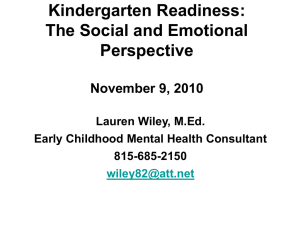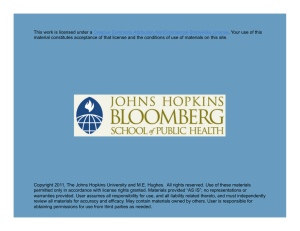Document 14523773
advertisement

February 2009 ESSAYS ON TRENDS, INNOVATIVE IDEAS AND CUTTING-EDGE RESEARCH IN HEALTH CARE Life Course Health Development: A New Approach for Addressing Upstream Determinants of Health and Spending Neal Halfon MD, MPH, Director, UCLA Center for Healthier Children, Families, and Communities, and Professor of Pediatrics, Health Sciences and Public Policy A Revolution in our Understanding of Health Development The past two decades have witnessed phenomenal advances in our understanding of how health and disease develop. The field of life course chronic disease epidemiology has yielded hundreds of influential population-level studies demonstrating the link between early life events and the occurrence of many common chronic diseases that usually manifest in adulthood.2 Meanwhile, complementary research on the developmental origins of adult disease is pinpointing the mechanisms by which early events are programmed into the developing immune, neurological, endocrine and other physiologic Figure 1: How Risk Reduction and Health Promotion Strategies Influence Health Development Risk Reduction Health Development It is not unusual to criticize many public policies for doing “too little, too late.” Within the U.S. health care system, however, the more relevant criticism is that we do too much, too late. Most of our expenditures are dedicated to treating diseases that are already well established, and occur disproportionately at the end of life. While most cost containment strategies focus on using more cost effective care within the medical sector,advocates for population health rightly argue that tackling rising costs and improving our comparatively poor national health outcomes will require more attention to preventing disease by targeting the so-called “upstream” determinants of health. These determinants are factors upon which families and communities exert considerable influence, in addition to one’s physician. There is growing recognition that moving upstream also means addressing health risks earlier in the life span, during developmentally sensitive periods, when prevention, early intervention and health promotion can yield the greatest benefits.1 Rather than spending too much too late, we can spend more wisely and assure more optimal health outcomes by focusing on the early determinants of life-long health. RR RR RR HP HP HP Protective Factors 0 20 40 RR Risk Reduction Strategies HP Health Promotion Strategies Trajectory without RR and HP Strategies Optimal Trajectory Age (years) 60 80 Source: Halfon N, Inkelas M, Hochstein M. "The Health Development Organization: An Organizational Approach to Achieving Child Development." Milbank Quarterly. 2000; 78(3):447-97. systems. These studies are disentangling, for example, how relative malnutrition of the fetus can lead to lasting physiologic changes in fat and carbohydrate metabolism, increasing the risk of diabetes, heart disease, hypertension and obesity in adulthood. Other studies demonstrate that individuals inheriting a common variant of a gene that influences serotonin levels in the brain are more likely to develop depression as a teen or adult when they have a childhood exposure to the high stress levels typically associated with extreme poverty. Life Span, Life Stage and Life Course Health Development This research has led to a burgeoning interest in Life Course Health Development (LCHD) as a model for better understanding the development of disease and the promotion of health. The LCHD approach builds on the life span (longitudinal connections) and life stage (developmental periods) models by specifying the biological and behavioral mechanisms that determine health trajectories. From a LCHD perspective, health is a developmental process occurring throughout the lifespan. The two different health trajectories depicted in Figure 1 show that the earlier years establish different levels of functional health development, followed by stabilization of health trajectories during the middle years, and decline towards the end of life. The different life-long health trajectories are the result of competing influences. Risk factors that make us more vulnerable to disease exert downward pressure on the health trajectory while protective factors that mitigate risk and enhance resilience support more optimal health functioning. Achieving an optimal trajectory can have a positive effect on health throughout the life span, including delaying the onset of serious problems that lead to functional limitations later in life. The implications for our nation’s health spending are clear if we can delay disability and compress the period when morbidities are present. Hertzman, Halfon and others have suggested that the health development process is determined not just by the cumulative impact of risk and protective factors but by the timing of exposures.1,3 For example, neurological research has taught us that there are specific periods that are critical to brain development for different types of functioning. When positive or negative influ- NIHCM FOUNDATION: 1225 19th Street, NW, Suite 710, Washington, DC 20036 • tel: 202.296.4426 • fax: 202.296.4319 • web: www.nihcm.org PED Figure 2: Trajectory Optimizing Service Linkage Pathway Optimal Health Development Trajectory FRC Tutor PED SR Lower Health Development Trajectory FRC PED PED FRC NHV ROR Pediatric medical home Family resource center Nurse home visiting program Reach Out and Read early literacy program SR = School readiness program ROR FRC PED NHV FRC 0 1 2 3 4 ences occur during these periods, their impacts can be stronger and more lasting than when the same exposures occur at other times. Thus, there are optimal times for positive interventions or – more pointedly – missed opportunities when these interventions do not occur during the important developmental periods. Likewise, there are periods of heightened vulnerability, during which negative exposures can be especially damaging. Transforming Children’s Health The LCHD model necessarily shifts more focus to the early part of the life span, when long-term health programming is most intense and higher levels of developmental plasticity enable interventions to exact greater returns on resources invested. In many cases, promoting optimal lifelong health may be best achieved through means other than “traditional” health care interventions. For example, we know from the work of Nobel Laureate James Heckman and others that comparatively moderate investments in good quality early education and care can enhance the development of literacy and other school readiness skills that predict educational outcomes and workforce readiness as well as long-term health. Although our understanding of the mechanisms underlying health trajectories is still nascent, it is increasingly clear that we can no longer afford to delay investment in early development and children’s health. Even as the evidence is being gathered, we can begin designing a system that is more likely to promote better health and developmental outcomes. Figure 2 provides a schematic depiction of two developmental trajectories. The more positive trajectory is supported by a scaffolding of evidence-based programs. At each time period 5 6 = = = = 7 years children are afforded the benefit of the basic supports they may need, including appropriate health care, family support and early learning experiences. This diagram also shows that these services are integrated both horizontally across the health, education and family support sectors as well as longitudinally over time. In the ideal scenario, a comprehensive health information system tracks children across settings and across time. By linking and integrating these evidence-based programs, we can create the service delivery scaffolding necessary to help children withstand the stressors that inevitably emerge during childhood and ultimately support a more optimal developmental trajectory. Many nations have already begun to construct such a scaffolding by guaranteeing meaningful health care coverage, routinely utilizing teams of visiting maternal child health nurses, establishing readily accessible child care and child development centers, and providing other income and family support for families with young children. These kinds of supportive measures are now the norm in the Scandinavian countries, France, the Netherlands, many parts of Italy, Spain and elsewhere. Interestingly, the English speaking countries – the U.S., U.K., Canada and Australia – have lagged behind in developing systems of early childhood supports. It should come as no surprise, then, that they have also consistently ranked low on measures of child health and well-being compared to other nations.4 In an effort to improve this poor performance over the past decade, the U.K., Canada, and Australia have all adopted new early childhood policy agendas. England has led the way with its ambitious Sure Start Program, which will build 3,500 centers, each serving as the hub of a support scaffolding network in a low income neigh- borhood.5 Canada and Australia are instituting systems to measure the health, development and school readiness of all five-year olds.6,7 Only the U.S. has failed to take aggressive steps toward implementing structural and financing changes that will provide our children with opportunities for optimal development. Without correction, this deficit is likely to lead to widening performance gaps when the U.S. is compared to populations abroad. Conclusions The LCHD framework prioritizes life-long prevention and provides a powerful rationale for health system transformation.8 This transformation will require meaningful health insurance coverage for all children plus significant investments in community-based prevention, health promotion, developmental support services, and information systems to provide the health development scaffolding that children need to thrive. Innovative funding mechanisms will also be needed, such as a children’s health and wellness trust that could fund cross-sector approaches to prevention and assure investments over longer time horizons. Adopting this strategy would help to reverse the alarming trend of diminishing investments for the youngest generation, a dangerous course for any nation that envisions a strong future. By adopting the logic of the LCHD framework, the U.S. health system can be transformed from a system that provides too much care too late, toward a more rational, higher-performing system that emphasizes early, high-return invest■ ments. 1 Halfon N, Hochstein M. “Life course health development: an integrated framework for developing health, policy, and research.” Milbank Quarterly. 2002;80(3):433-79, iii. 2 Kuh D, Ben-Shlomo Y, Eds. A Life Course Approach to Chronic Disease Epidemiology, 2nd Edition. Oxford: Oxford University Press, 2004. 3 Hertzman C, Power C, Matthews S, Manor O. “Using an interactive framework of society and lifecourse to explain self-rated health in early childhood.” Social Science & Medicine. 2001; 53:1575-85. 4 UNICEF, Innocenti Research Centre. Child Poverty in Perspective: An Overview of Child Well-Being in Rich Countries, Innocenti Report Card 7. Florence, Italy: UNICEF, 2007. 5 United Kingdom Sure Start Programme. http:// www.surestart.gov.uk/aboutsurestart/about/thesurestartprogramme2/. Accessed 22-Dec-2008 6 The Royal Children’s Hospital Melbourne. Australian Early Development Index. http://www.rch.org.au/australianedi/ edi.cfm?doc_id=6211. Updated 16-Dec-2008. Accessed 22-Dec 2008. 7 Offord Centre for Child Studies. School Readiness to Learn Project (SRL): Early Development Instrument. http://www.offordcentre.com/readiness/. Accessed 22Dec-2008 8 Halfon N, DuPlessis H, Inkelas M. “Transforming the U.S. child health system.” Health Affairs. 2007; 26(2):315-30. NIHCM FOUNDATION: 1225 19th Street, NW, Suite 710, Washington, DC 20036 • tel: 202.296.4426 • fax: 202.296.4319 • web: www.nihcm.org


